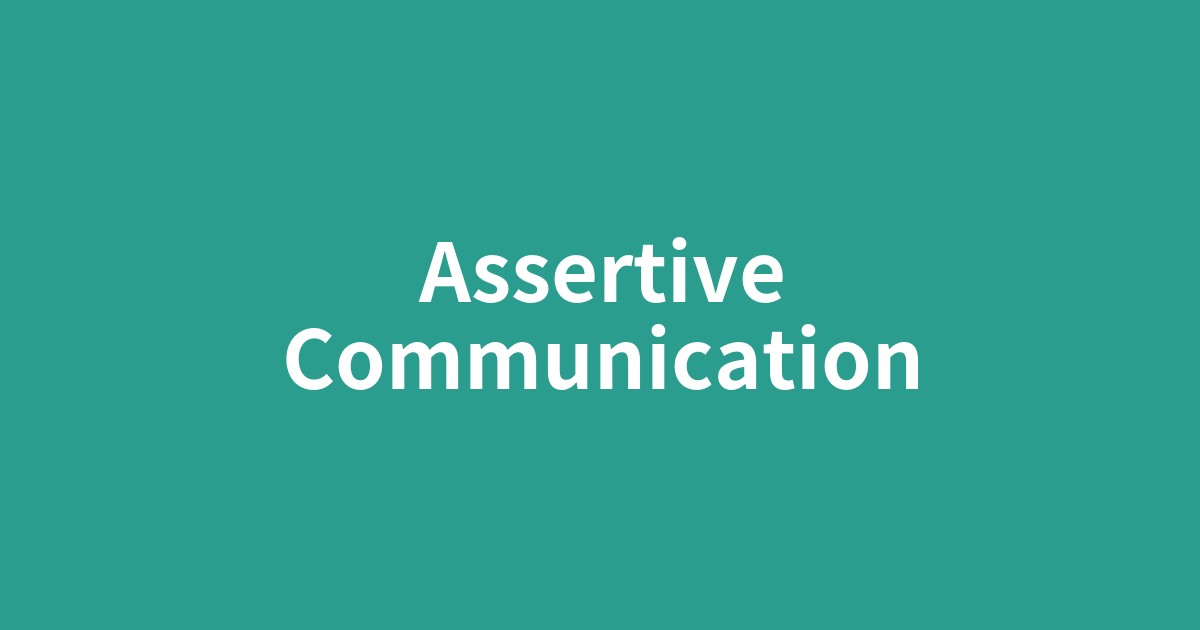このページは、歴史や文化の物語を楽しみながら、その文脈の中で重要な英単語を自然に学ぶための学習コンテンツです。各セクションの下にあるボタンで、いつでも日本語と英語を切り替えることができます。背景知識を日本語で学んだ後、英語の本文を読むことで、より深い理解と語彙力の向上を目指します。

攻撃的でも、受け身でもなく、自分の意見や感情を正直かつ誠実に伝えるassertive(主張的な)コミュニケーションの技術。
この記事で抑えるべきポイント
- ✓アサーティブ・コミュニケーションとは、攻撃的(Aggressive)でも受動的(Passive)でもない、第三の自己表現スタイルであるという点。
- ✓自分の意見や感情を正直に伝えつつ、相手の権利や意見も尊重するという「相互尊重(Mutual Respect)」の精神が核であること。
- ✓アサーティブネスは、元々1940年代の行動療法の中から生まれた心理学的アプローチであり、自己表現を基本的な「権利(Rights)」と捉える考え方に基づいている点。
- ✓具体的な実践方法として、相手を主語にする「Youメッセージ」ではなく、自分を主語にする「Iメッセージ」が有効であるという技術。
- ✓アサーティブな対話は、短期的な対立を避けるのではなく、長期的に健全な人間関係を築き、自己肯定感(Self-esteem)を高める効果が期待できるという視点。
アサーティブ・コミュニケーション ― 自分も相手も大切にする伝え方
「言いたいことを我慢して後悔した」「つい感情的に言い過ぎてしまった」。多くの人が経験するこうした悩みに、解決の糸口はあるのでしょうか。本記事では、単なる性格の問題ではなく、技術として習得可能とされる「アサーティブ・コミュニケーション」という考え方を紹介します。自分も相手も大切にする、新しい対話の可能性を探ります。
Assertive Communication: A Way to Value Both Yourself and Others
"I regretted holding back what I wanted to say." "I accidentally said too much in the heat of the moment." Is there a solution to these common frustrations? This article introduces the concept of assertive communication, not as a personality trait, but as a skill that can be learned. Let's explore the potential for a new kind of dialogue that values both ourselves and others.
アサーティブとは何か? ― 3つのコミュニケーションタイプ
私たちの対話スタイルは、大きく3つに分類できると言われています。一つ目は、自分の意見を言えず、相手に合わせてしまう「受動的(passive)」なスタイル。二つ目は、相手の気持ちを考えずに自分の意見を押し通す「攻撃的(aggressive)」なスタイルです。そして三つ目が、今回ご紹介する「主張的(Assertive)」なスタイルです。これは、自分の気持ちや意見を正直に伝えながら、同時に相手の意見や権利も尊重するという、バランスの取れた自己表現を指します。このアサーティブネス(Assertiveness)こそが、人間関係の質を左右する「コミュニケーション(communication)」において、自分と相手双方にとって望ましい結果をもたらす鍵となるのです。
What is Assertiveness? — Three Communication Types
Our communication styles can be broadly categorized into three types. The first is a "passive" style, where we fail to express our own opinions and yield to others. The second is an "aggressive" style, where we push our own opinions without considering the other person's feelings. And the third is the "assertive" style we introduce today. This refers to a balanced form of self-expression where you honestly convey your own feelings and opinions while also respecting the opinions and rights of the other person. This assertiveness is the key to achieving desirable outcomes for both parties in the kind of "communication" that determines the quality of our relationships.
自己表現は「権利」である ― アサーティブネスの心理学的ルーツ
アサーティブネスという概念は、決して新しいものではありません。その起源は1940年代のアメリカに遡ります。元々は、自己表現に不安を抱える人々を支援するための行動療法の一環として開発されたトレーニングでした。このアプローチの根底にあるのは、「誰もが自分の意見や感情を表現する基本的な『権利(Rights)』を持っている」という考え方です。つまり、アサーティブな自己表現は、単なるわがままや自己中心的な振る舞いとは一線を画し、人間として誰もが持つべき正当な権利であると位置づけられているのです。
Self-Expression is a "Right" — The Psychological Roots of Assertiveness
The concept of assertiveness is not new. Its origins trace back to the 1940s in the United States. It was originally developed as a training method within behavior therapy to support people who struggled with self-expression. Underlying this approach is the idea that everyone has the basic "rights" to express their own opinions and feelings. In other words, assertive self-expression is distinct from mere selfishness or self-centered behavior; it is positioned as a legitimate right that every human being should have.
「私」を主語にする魔法 ― 実践、アサーティブな伝え方
では、どうすればアサーティブな伝え方ができるのでしょうか。その具体的な技術として最も有名なのが「I(アイ)メッセージ」です。これは、「あなたが〜したから、私は不快だ」というように相手を主語にする「Youメッセージ」とは対照的に、「私は〜と感じる」「私は〜してほしい」と、自分を主語にして伝える方法です。例えば、相手に何かを伝える際、非難するのではなく、客観的な事実と自分の感情をセットにして誠実な「フィードバック(feedback)」として渡すのです。この伝え方は、相手への「尊重(respect)」を保ちながら、自分の気持ちを正直に表現することを可能にし、建設的な対話への扉を開きます。
The Magic of Using "I" as the Subject — Practicing Assertive Communication
So, how can we communicate assertively? The most famous technique is the "I-message." This is in contrast to "You-messages," which place the other person as the subject, such as "You did this, so I'm upset." Instead, the I-message method involves speaking with yourself as the subject, saying "I feel..." or "I would like you to..." For instance, when conveying something to someone, you deliver honest "feedback" by pairing objective facts with your own feelings, rather than blaming them. This method allows you to honestly express your feelings while maintaining "respect" for the other person, opening the door to constructive dialogue.
「和」を重んじる文化と、どう向き合うか?
「空気を読む」ことや調和を大切にする文化の中では、自分の意見をはっきりと主張することに抵抗を感じる人も少なくないでしょう。しかし、アサーティブネスの本質を理解すると、それが日本の文化と決して対立するものではないことがわかります。アサーティブな対話は、相手の立場や感情を想像する力、すなわち「共感(empathy)」を伴います。自分の考えに対して「正直さ(honesty)」を保ちつつも、それをどう伝えれば相手が受け入れやすいかを考える。これは、表面的な調和を保つために我慢を重ねるのではなく、真に信頼できる長期的な関係を築く上で、むしろ非常に有効な手段となり得るのです。
How to Approach a Culture That Values Harmony?
In a culture that values "reading the air" and harmony, many people may feel resistant to stating their opinions clearly. However, a true understanding of assertiveness reveals that it is not necessarily in conflict with such a culture. Assertive dialogue involves the ability to imagine the other person's position and feelings—that is, "empathy." It means maintaining "honesty" about your own thoughts while considering how to convey them in a way the other person can accept. This is not about enduring in silence to maintain superficial harmony, but rather a highly effective means of building truly reliable, long-term relationships.
結論:自己肯定感を育む、対話の技術
アサーティブ・コミュニケーションは、自分を犠牲にすることなく、また相手を傷つけることもなく、対等な立場で対話するための技術です。一朝一夕で身につくものではなく、日々の意識と練習が必要なスキルかもしれません。しかし、自分の気持ちや考えを適切に表現できるようになることは、健全な「自己肯定感(self-esteem)」を育むことにも繋がります。自分も相手も大切にするこの対話法は、より豊かで対等な人間関係を築くための、確かな一歩となるでしょう。
Conclusion: A Dialogue Technique to Nurture Self-Esteem
Assertive communication is a technique for engaging in dialogue on an equal footing, without sacrificing yourself or hurting others. It may not be a skill acquired overnight, requiring daily awareness and practice. However, being able to properly express your feelings and thoughts also helps to nurture healthy "self-esteem." This method of dialogue, which values both yourself and others, will surely be a firm step toward building richer, more equitable relationships.